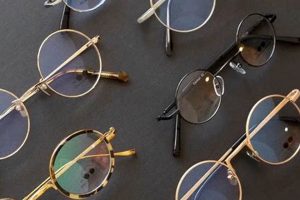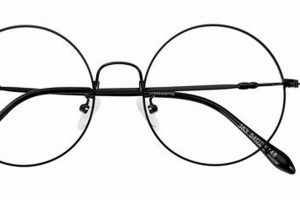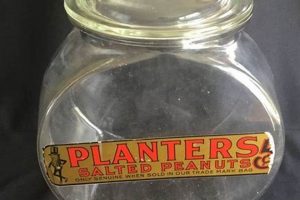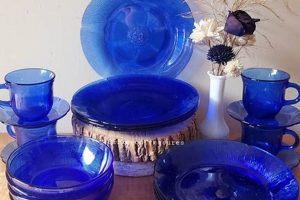These collectible items, often dating back several decades or more, represent a bygone era of manufacturing and commerce. Characterized by their transparent composition and aged appearance, they were originally produced for various purposes, ranging from medicine and beverages to household products. Variations in shape, size, and embossing provide clues to their origin, manufacturer, and intended use. A notable example includes those used for early Coca-Cola products, which are highly sought after by collectors.
The appeal of these objects lies in their historical significance and aesthetic qualities. They offer a tangible connection to the past, providing insights into the social and economic landscapes of previous generations. Furthermore, their transparency allows for the appreciation of their form and the potential display of contents, making them decorative assets in modern interiors. Historically, their widespread use reflects a time when glass was a primary material for packaging and storage, preceding the prevalence of plastics. The transition to alternative materials led to their transformation from functional objects to valued collectibles.
Subsequent sections will delve into specific aspects, including methods for identification and authentication, cleaning and preservation techniques, and the current market trends influencing their valuation. Furthermore, the diverse applications beyond collecting, such as repurposing for home dcor and artistic endeavors, will be explored.
Collecting and Preserving Vintage Clear Glass Bottles
The acquisition and maintenance of vintage clear glass bottles require careful attention to detail to ensure both preservation of the artifacts and informed purchasing decisions.
Tip 1: Authentication Through Markings: Scrutinize any embossed or etched markings on the bottle’s surface. These markings often indicate the manufacturer, date, and location of production. Reference historical databases and bottle identification guides to verify authenticity.
Tip 2: Assessing Condition: Thoroughly examine the bottle for chips, cracks, scratches, and discoloration. While minor imperfections may be acceptable based on age and rarity, significant damage can considerably reduce value and structural integrity.
Tip 3: Proper Cleaning Protocols: Employ gentle cleaning methods, avoiding harsh chemicals or abrasive materials. Warm water and mild soap are generally sufficient. For stubborn residue, consider using diluted vinegar or specialized bottle cleaning solutions. Rinse thoroughly and air dry to prevent water spots.
Tip 4: Safe Storage Practices: Store bottles in a stable environment, away from direct sunlight, extreme temperatures, and high humidity. Consider individual padded storage containers or display cases to minimize the risk of accidental damage.
Tip 5: Research Market Values: Consult reputable online marketplaces, auction results, and price guides to gain an understanding of current market values. Factor in condition, rarity, historical significance, and collector demand when evaluating potential purchases.
Tip 6: Identifying Manufacturing Imperfections: Observe the glass for bubbles, striations, or uneven thickness. These imperfections are commonly found in older, hand-blown or early machine-made bottles and, paradoxically, can often serve as indicators of authenticity rather than flaws.
Consistent attention to authentication, condition assessment, proper cleaning, secure storage, and market awareness contributes to the responsible collecting and long-term preservation of these historical objects.
The following sections will explore the artistic repurposing and decorative potential of these unique items.
1. Origin
The origin of vintage clear glass bottles is paramount in determining their value, historical context, and appeal to collectors. Tracing a bottle’s provenance unlocks critical insights into its production, intended use, and cultural significance.
- Manufacturer Identification
The manufacturer’s mark, often embossed on the bottle’s base or side, provides direct evidence of its origin. Researching the history of specific manufacturers, such as Owens-Illinois or Wheaton, reveals details about their production techniques, product lines, and geographic locations. This information helps to narrow down the bottle’s age and potential rarity. For instance, a bottle bearing the mark of a short-lived or regional glassworks may be more valuable than one from a large, well-established company.
- Geographic Location of Production
The location where a bottle was produced impacts its chemical composition due to regional variations in raw materials. Analysis of the glass itself can sometimes pinpoint the specific region or even glassworks responsible for its creation. Furthermore, geographic location often correlates with specific bottle styles and intended uses. For example, certain shapes of soda bottles were prevalent in the Southern United States, reflecting regional preferences and bottling practices.
- Date of Manufacture
While not always explicitly marked, the manufacturing date can often be inferred from bottle characteristics, such as mold seams, closure types, and glass color. Researching historical bottle manufacturing techniques and closure innovations allows for a relatively precise dating. Patent dates embossed on the bottle are particularly useful. Knowing the date is crucial for determining whether the bottle is genuinely vintage and for understanding its historical context. For example, a bottle produced during a specific war era might reflect material shortages or wartime regulations.
- Intended Contents and Usage
The original purpose of a bottle whether it held medicine, soda, perfume, or another substance directly relates to its origin and target market. Specific shapes, sizes, and closures were designed for particular contents, ensuring product integrity and user convenience. Pharmaceutical bottles, for instance, often feature amber-colored glass to protect light-sensitive compounds. Understanding the intended contents provides insights into the bottle’s historical role and its connection to consumer practices of the past.
These elements of origin collectively provide a comprehensive understanding of a vintage clear glass bottle’s history and value. Careful analysis of these facets enables informed collecting, preservation, and appreciation of these tangible artifacts from the past. Detailed exploration of origin, therefore, separates a casual observation from serious investigation, elevating the discourse of glass bottle collecting to a more profound exploration of history.
2. Manufacturing
The manufacturing processes employed in the creation of vintage clear glass bottles fundamentally define their characteristics and value. The transition from manual techniques to automated production significantly influenced the quality, consistency, and availability of these items. Early bottles, often produced through glassblowing or rudimentary molding, exhibit imperfections such as bubbles, asymmetrical shapes, and variations in glass thickness. These irregularities, paradoxically, now serve as authenticating features, distinguishing them from later mass-produced examples. An examination of mold seams, pontil marks, and the presence of applied finishes provides insight into the manufacturing methods employed and the approximate age of the piece. The shift towards mechanized production in the late 19th and early 20th centuries resulted in standardized shapes, clearer glass, and increased output, impacting both the aesthetic and collectibility of subsequently produced bottles. The impact is evident when comparing a pre-1900 hand-blown medicine bottle with a machine-made soda bottle from the 1920s; the former displays unique, individual characteristics reflecting the artisan’s hand, while the latter exemplifies the precision and uniformity achievable through automation.
Furthermore, understanding the specific manufacturing techniques used by different glassworks is essential for accurate identification and valuation. Companies like Owens-Illinois developed innovative processes, such as the automated bottle-making machine, which revolutionized the industry. Bottles produced using these methods bear distinct hallmarks, including specific mold numbers and company logos, enabling collectors to attribute them accurately. Knowledge of glass composition and the use of additives, such as manganese (to counteract iron impurities and enhance clarity), also provides valuable clues about the manufacturing era. For example, the presence of a slight amethyst tint in clear glass bottles indicates the use of manganese that, upon exposure to ultraviolet light over time, underwent a chemical change. These nuanced details allow for a more comprehensive appreciation of the technical advancements and manufacturing practices that shaped the production of these containers.
In summary, the manufacturing process is inextricably linked to the identity and worth of vintage clear glass bottles. Examining these production methods offers a critical lens through which to assess their authenticity, age, and historical significance. While mass production led to increased availability, the imperfections and unique characteristics of earlier, handcrafted bottles contribute significantly to their collectibility. Challenges remain in accurately dating and attributing bottles due to variations in manufacturing practices and incomplete historical records, necessitating careful examination and informed analysis. The manufacturing process informs every aspect, from form to color, thus making the understanding of this aspect absolutely essential.
3. Shape
The shape of a vintage clear glass bottle is a crucial indicator of its intended use, period of manufacture, and often, its manufacturer. Variations in form directly reflect the functional requirements of the original contents, the prevailing aesthetic sensibilities of the time, and the technological capabilities of glass production.
- Functional Design and Intended Use
Bottle shapes were meticulously designed to accommodate specific contents, whether liquids, solids, or powders. For instance, narrow-necked bottles were frequently used for pouring liquids like medicine or perfume, while wide-mouthed jars were suitable for storing food items or ointments. The curvature of the bottle’s shoulder and base, as well as the presence of embossed patterns, often served to improve grip or prevent spillage. The presence of a “hobble skirt” design, characterized by a constricted middle section, often indicates a bottle intended for carbonated beverages, designed to withstand internal pressure.
- Influence of Manufacturing Techniques
Early manufacturing techniques, such as hand-blowing, limited the complexity of shapes that could be produced. Hand-blown bottles often exhibit subtle irregularities and variations in wall thickness, whereas machine-made bottles are characterized by greater uniformity and precision. The introduction of automatic bottle-making machines in the early 20th century allowed for the mass production of standardized shapes, leading to a shift from organic, hand-crafted forms to more geometric and symmetrical designs. Examining mold seams and other manufacturing marks can thus provide insights into the production methods employed and the bottle’s approximate age.
- Aesthetic Trends and Period Styles
Bottle shapes were also influenced by prevailing aesthetic trends and design movements. Art Nouveau, Art Deco, and Victorian styles each left their mark on bottle design, with ornate decorations, elaborate embossing, and distinctive silhouettes reflecting the tastes of the era. For example, perfume bottles from the early 20th century often featured intricate floral motifs and curvilinear forms characteristic of Art Nouveau, while those from the Art Deco period exhibited streamlined, geometric designs.
- Regional Variations and Brand Identity
Certain bottle shapes were specific to particular regions or brands, serving as a form of visual branding and product differentiation. For example, the distinctive shape of the Coca-Cola bottle, with its contoured silhouette, became instantly recognizable and synonymous with the brand. Regional variations in bottle shapes reflect local preferences and bottling practices, with certain styles being more prevalent in specific geographic areas. Identifying these regional and brand-specific shapes can aid in determining the bottle’s origin and historical context.
In summary, the shape of a vintage clear glass bottle represents a confluence of functional requirements, manufacturing capabilities, aesthetic trends, and branding strategies. By analyzing the shape, collectors and historians can gain valuable insights into the bottle’s intended use, period of manufacture, and cultural significance. These multifaceted influences converge to render each bottle shape a unique expression of its time.
4. Contents
The original contents of vintage clear glass bottles offer essential clues to their purpose, historical context, and potential value. Analyzing residue, labels (if present), and bottle morphology provides insights into the substances they once held and, consequently, the industries and consumer practices of the past.
- Pharmaceuticals and Medical Preparations
Many vintage clear glass bottles were designed to contain medicinal liquids, powders, or tablets. Shape, size, and color (often amber to protect light-sensitive compounds) were dictated by the specific pharmaceutical requirements. Embossed markings frequently included the name of the druggist or apothecary, the product name, and instructions for use. Remnants of these substances, while potentially hazardous, provide critical information about medical practices and available treatments of the era. For example, bottles once containing patent medicines, often unregulated and of questionable efficacy, illustrate the historical context of healthcare and consumer vulnerability.
- Beverages: Alcoholic and Non-Alcoholic
A significant portion of vintage clear glass bottles were used for bottling beverages, ranging from carbonated sodas and mineral waters to alcoholic drinks such as beer, wine, and spirits. Bottle shape, closure type, and the presence of applied color labels provide clues to the beverage type and brand. Early Coca-Cola bottles, for instance, are highly collectible due to their distinctive shape and historical association with the iconic brand. Examining the glass for residue or stains can further identify the original contents, even in the absence of a label. The evolution of beverage bottling techniques and the materials used reflect changing consumer preferences and technological advancements in the food and beverage industry.
- Household and Industrial Products
Vintage clear glass bottles were also employed for storing and dispensing household and industrial products, including cleaning solutions, inks, solvents, and cosmetics. The shape and size of these bottles varied widely, depending on the product’s viscosity, volume, and intended use. Bottles used for storing corrosive substances often exhibit thicker glass walls and specialized closures to prevent leakage or contamination. Identifying the original contents through residue analysis or remaining labels provides insights into historical household practices and the types of products available to consumers. The presence of hazardous materials necessitates careful handling and disposal to ensure safety.
- Foodstuffs and Preserves
Clear glass bottles were used to preserve and store a range of foodstuffs, including sauces, condiments, jams, and pickled goods. The closure mechanisms, such as corks, stoppers, or screw-top lids, were designed to create an airtight seal and prevent spoilage. Embossed markings sometimes included the brand name or the type of food contained within. The shape and size of the bottle often reflected the intended shelf life and method of preservation. Analyzing residue or remnants of the original contents can provide valuable information about historical food preservation techniques and dietary habits.
These diverse applications highlight the critical role of clear glass bottles in various industries and aspects of daily life. Recognizing the original contents not only enhances the appreciation of these vintage objects but also provides a tangible link to the historical practices and consumer culture they represent. Accurate identification of contents also informs appropriate handling and preservation techniques, ensuring their continued value as historical artifacts.
5. Markings
Markings on vintage clear glass bottles serve as essential indicators of origin, manufacturing period, intended use, and authenticity. These inscriptions, typically embossed, etched, or applied as labels, provide invaluable information for collectors, historians, and researchers, transforming a seemingly simple object into a tangible artifact laden with historical context.
- Manufacturer’s Marks and Logos
The presence of a manufacturer’s mark or logo is often the most direct means of identifying the bottle’s source. Companies such as Owens-Illinois, Ball, and Hazel-Atlas utilized distinctive symbols and lettering styles that can be cross-referenced with historical records to pinpoint the manufacturer and approximate production dates. The absence or presence of specific logos can indicate the age of the bottle, as companies frequently updated their branding over time. These marks serve as a primary identifier, analogous to a signature on a work of art, allowing for the attribution of the bottle to a specific producer.
- Date Codes and Production Indicators
Many glass manufacturers incorporated date codes or other production indicators into their markings. These codes, often cryptic to the untrained eye, provide precise information about the year, month, or even day of manufacture. These codes adhere to proprietary systems specific to each manufacturer, necessitating detailed research to decipher. Date codes are critical for establishing the bottle’s age and for verifying its authenticity, particularly in cases where reproductions or forgeries exist. An understanding of date code systems allows for a more accurate assessment of the bottle’s historical context and value.
- Embossed Text and Product Information
Beyond manufacturer identification, embossed text on vintage clear glass bottles frequently provides information about the product the bottle contained, its intended use, or even the location where it was bottled or sold. Pharmaceutical bottles, for example, often featured the name of the apothecary or the specific medicinal preparation. Beverage bottles might display the brand name, volume, or patent information. This embossed text serves as a direct advertisement or informational message, reflecting the marketing practices and consumer regulations of the time. Deciphering this information provides insights into the types of products available to consumers and the regulatory environment in which they were produced.
- Patent Numbers and Design Registrations
The inclusion of patent numbers or design registration marks indicates that the bottle’s design or manufacturing process was protected by intellectual property laws. These numbers can be researched through patent databases to reveal the inventor, the date of the patent, and the specific innovation that was patented. Patent numbers offer valuable insights into the technological advancements and design innovations that shaped the bottle’s production. They also provide a verifiable record of the bottle’s originality and its place within the history of glass manufacturing.
In conclusion, markings on vintage clear glass bottles represent a rich source of information, providing essential clues to their origin, manufacturing history, intended use, and cultural significance. These inscriptions transform these containers from mere objects into tangible records of the past, allowing for a deeper understanding of the industries, products, and consumer practices of previous generations. Their study demands diligent research and careful interpretation, unlocking their latent historical value and preserving their stories for future generations.
6. Condition
The condition of vintage clear glass bottles significantly impacts their value, collectibility, and historical integrity. It is a primary determinant in assessing authenticity and desirability among collectors and historians. The state of preservation reflects the object’s history, storage environment, and handling over time.
- Surface Flaws and Abrasions
Scratches, scuff marks, and surface abrasions are common on vintage clear glass bottles, resulting from handling, storage, and use. While minor imperfections may be acceptable on older or rarer specimens, extensive surface damage detracts from the bottle’s aesthetic appeal and reduces its market value. The presence of heavy abrasions can obscure embossed markings or labels, hindering accurate identification and authentication. Bottles that have been subjected to harsh cleaning methods or abrasive materials often exhibit a dull, cloudy appearance, diminishing their clarity and visual appeal. The absence of significant surface flaws often indicates meticulous care or limited use, increasing the bottle’s desirability.
- Structural Damage: Cracks and Chips
Cracks and chips represent more severe forms of damage that compromise the structural integrity of vintage clear glass bottles. Cracks, whether hairline or extensive, weaken the glass and increase the risk of further breakage. Chips, particularly around the lip or base of the bottle, detract from its aesthetic appeal and can render it unsuitable for display. The presence of structural damage significantly reduces the bottle’s value and may require professional restoration to prevent further deterioration. Bottles with significant structural flaws are generally considered less desirable to collectors, except in cases of extreme rarity or historical significance.
- Discoloration and Staining
Discoloration and staining can occur in vintage clear glass bottles due to prolonged exposure to light, heat, or the original contents. Sunlight can cause the glass to develop a purple or amber tint, a phenomenon known as solarization. Staining from the original contents, such as medicines, beverages, or chemicals, can permanently alter the glass’s color and transparency. While some forms of discoloration may be aesthetically appealing or indicative of age, excessive staining detracts from the bottle’s clarity and can obscure embossed markings. Attempts to remove staining can sometimes damage the glass further, requiring careful consideration and appropriate cleaning methods.
- Internal Residue and Contamination
The presence of internal residue or contamination can affect the condition and value of vintage clear glass bottles. Residue from the original contents, such as dried liquids, powders, or sediments, can be difficult to remove and may alter the appearance of the glass. Contamination from mold, bacteria, or other microorganisms can also affect the bottle’s integrity and pose potential health hazards. Thorough cleaning and disinfection are essential to ensure the bottle’s safety and prevent further deterioration. The presence of extensive internal residue or contamination can diminish the bottle’s aesthetic appeal and may require specialized cleaning techniques.
These facets collectively define the condition of vintage clear glass bottles, influencing their value, desirability, and historical significance. Careful assessment of these factors is crucial for collectors, historians, and anyone seeking to preserve these tangible links to the past. The degree of preservation, as reflected in these facets, ultimately dictates the objects longevity and enduring appeal.
7. Rarity
In the realm of vintage clear glass bottles, rarity serves as a primary driver of value and collectibility. It encapsulates a confluence of factors that determine how scarce a particular bottle is, thereby significantly influencing its desirability and market price. The scarcity is not merely about age, but a complex interplay of production volume, survival rates, and historical significance.
- Limited Production Runs
Bottles produced in small quantities, often due to experimental designs, short-lived manufacturing periods, or specific historical events, command higher prices. An example includes bottles produced during wartime material shortages, where certain glass colors or shapes were temporarily discontinued, leading to a limited number in circulation. These short production runs can make even relatively recent bottles highly sought after. Conversely, mass-produced bottles from common eras are generally less valuable, irrespective of age, unless they possess unique features or variations.
- Low Survival Rates
The fragility of glass and its vulnerability to damage over time contribute significantly to scarcity. Bottles used for everyday purposes were often discarded or broken, leading to a low survival rate for certain types. This is particularly true for bottles containing hazardous materials or those used in industrial settings, where breakage was common. Therefore, a bottle that was originally common may become rare simply due to attrition over decades. The probability of finding an intact specimen decreases with time, increasing its desirability among collectors.
- Geographic Specificity
Bottles produced and distributed in limited geographic regions can be considered rare due to their localized availability. This is especially true for bottles associated with regional breweries, apothecaries, or soda bottlers that operated within a limited area. Examples include bottles from defunct local businesses that never expanded beyond their initial market. Collectors often seek out these geographically specific bottles as representative artifacts of regional history, driving up their value within those collecting communities.
- Unique Manufacturing Defects or Variations
Bottles with distinctive manufacturing defects, such as unusual bubbles, color variations, or mold imperfections, can also achieve rarity status. While often considered flaws, these deviations from the standard production process make each bottle unique. These “errors” occurred during the manufacturing process and were not intentional alterations, thereby distinguishing them from designed variations. Collectors value these anomalies as evidence of the hand-crafted nature of early glass production or as unique markers of a specific manufacturing run. This unintentional uniqueness contributes to their scarcity and value.
The interplay of limited production, low survival rates, geographic specificity, and unique manufacturing variations defines the rarity of vintage clear glass bottles. These factors underscore the complex considerations that drive value in the collecting world, highlighting the importance of both historical context and tangible evidence of scarcity.
Frequently Asked Questions
This section addresses common inquiries regarding vintage clear glass bottles, offering clarity on key aspects relevant to collectors, historians, and enthusiasts.
Question 1: How does one determine the age of a vintage clear glass bottle?
Age determination involves analyzing several factors, including the presence of a manufacturer’s mark, the type of mold seams, and the glass composition. Bottle identification guides and historical resources can assist in deciphering these clues to approximate the production period.
Question 2: What factors contribute to the value of a vintage clear glass bottle?
Value is influenced by a combination of factors, including rarity, condition, historical significance, and aesthetic appeal. Bottles produced in limited quantities, those in excellent condition, and those associated with significant historical events command higher prices.
Question 3: How should vintage clear glass bottles be cleaned to avoid damage?
Gentle cleaning methods are recommended, utilizing warm water and mild soap. Abrasive cleaners and harsh chemicals should be avoided, as they can damage the glass surface. For stubborn residue, diluted vinegar or specialized bottle cleaning solutions may be employed with caution.
Question 4: What are the key differences between hand-blown and machine-made vintage clear glass bottles?
Hand-blown bottles typically exhibit irregularities in shape and wall thickness, as well as the presence of a pontil scar on the base. Machine-made bottles are characterized by greater uniformity, precise mold seams, and the absence of a pontil scar.
Question 5: How can one distinguish an authentic vintage clear glass bottle from a reproduction or fake?
Authentication requires careful examination of the bottle’s markings, shape, glass composition, and overall construction. Consulting with experienced collectors or experts in the field can provide valuable insights and assistance in identifying reproductions or forgeries.
Question 6: Where can one find reliable information about vintage clear glass bottles?
Reputable sources include historical societies, bottle collecting clubs, online databases dedicated to bottle identification, and scholarly articles published in relevant academic journals. Auction catalogs and price guides can also offer insights into current market trends.
These FAQs offer a foundational understanding of vintage clear glass bottles. Further exploration into specific aspects is encouraged for a more comprehensive appreciation of these historical artifacts.
The subsequent section will delve into the responsible collecting and ethical considerations related to vintage clear glass bottles.
Conclusion
The preceding exploration has illuminated the multifaceted nature of vintage clear glass bottles, revealing their significance beyond mere utilitarian objects. The analysis encompassed manufacturing techniques, the importance of markings and condition, and the critical role of rarity in determining value. Understanding these elements enables informed appreciation and responsible collecting of these historical artifacts.
As custodians of these tangible links to the past, careful preservation and ethical acquisition practices are paramount. Continued research and documentation of vintage clear glass bottles ensure their enduring value as cultural and historical resources for future generations.







